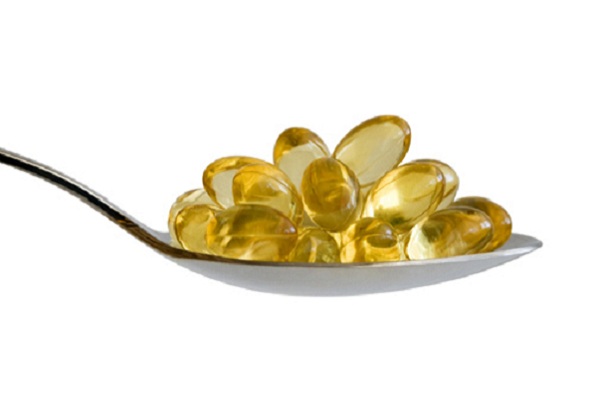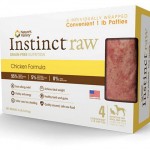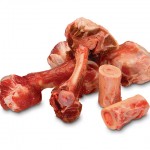First, let’s talk about how the fatty acids are named. “Essential” means needed, thus our bodies don’t make the fatty acid. The biochemical structure is what makes them fatty acids and helps with the different names. “Fatty” means the EFAs are used in the body in lipid (fatty) layers of cells and tissues. Where the first double bond is in the fatty acid molecule helps in the naming – an omega-3 fatty acid has the first double bond 3 carbon atoms from the naming end; an omega-6 has 6 carbon atoms until the first double bond; and an omega-9 has 9 carbon atoms before the first double bond.
Sources of omega-3s include flax, hemp and fish oil. Omega-6 sources include corn, soy, and nut oils, along with meats (chicken, beef, turkey, pork and lamb). Omega-9 comes primarily from olive oil, but also rapeseed oil and canola oil. Not all omega fatty acids are essential; all EFAs are omega fatty acids. For example, omega-9s are NOT essential – our bodies and our
dogs’ bodies can make omega-9s from other unsaturated fats in the diet.
The prime example of an omega-6 is Arachidonic Acid(AA). AA is not essential for dogs (or humans) – we ingest plenty of AA precursors when we eat meat. AA is vital for most cells in the body – it is part of the cellular lining – found in high concentrations in the brain, liver and muscles. However, AA is also heavily involved in building the effects of inflammation. Once inflammation starts (stress, vaccines, leaky gut, viruses, etc.), AA is shunted into pro-inflammatory pathways. This inflammation can, amongst other things, stimulate allergies or arthritis. This is when humans take an aspirin or Benadryl; and the pro-inflammatory cycle perpetuates as long-term use of anti-inflammatory medications adds stress and becomes pro-inflammatory. Similarly, our dogs are administered steroids and/or NSAIDs for these conditions.
The body has its own anti-inflammatory pathways – this is where the omega-3s come in (and a few omega-6s). It’s pretty common these days to see foods that boast they contain EPA and DHA – both omega-3 fatty acids derived from fish oils and microalgae. The omega-3 pathway inhibits the inflammatory effects of the AA pathway. So, the more omega-3s we ingest, the less inflammation we experience – same for our pets.
For the most part, our dogs (and cats) eat meat, especially if they are on raw diet. So, they are getting the omega-6s they need. It’s the omega-3s that are deficient from a predominantly meat-based diet. True, grass-fed meat sources have a more balanced ratio of omega-3s and omega-6s. But even though your meat sources may be grass-fed, the rest of our environment (pollution, stress, vaccines, illness, previous history, genetics) can lead to inflammation. Thus, supplementing with omega-3s can greatly help reduce inflammation in us and in our dogs and cats.
Which Omega-3s Should I Use?
So the question is which omega-3 supplement to use; as there are several: flax oil, black currant seed oil, fish oil and microalgae (Chlorella is an example of microalgae).
How to pick which omega-3 is also based on biochemistry.
- Flax seed oil is a source of alpha-linolenic acid (ALA) – a precursor to EPA and DHA – the “big gun” anti-inflammatory fatty acids.
- The body slowly converts ALA to another fatty acid present in black currant seed oil. The body then converts that acid into EPA, then slowly into DHA.
- But EPA and DHA are both already contained in fish oil.
So, why would you want to feed flax seed oil or black currant seed oil if you can just feed fish oil?
A few reasons: First, ALA has its own anti-inflammatory effects all by itself, independent of the EPA/DHA pathway. Second, it all depends on the quality of the oil you buy. Inexpensive EFA products have poor quality and poor quantity of ingredients – a poor quality flax oil will have only 32% ALA, whereas a high quality product will contain 57% ALA. Poor quality fish
oil is often made from genetically engineered fish; fish concentrate heavy metals and PCBs in their fat (where the omega fatty acids come from). High quality fish oils are more expensive and are made from small fish from cold waters.
From human and animal studies, it is known that EPA and DHA have the following benefits: anti-inflammatory, anti-depressant, anti-psychotic, cardio-protective, and anti-cancer.
Benefits of Omega-6 Fatty Acids
One more thing to discuss is about the beneficial omega-6 fatty acids. These are found in borage oil, black currant seed oil (yes, both 3 and 6), hemp oil and evening primrose oil. GLA – gamma-linolenic acid – is the “good” omega-6 fatty acid found in these oils. GLA has been shown to decrease inflammation in inflammatory and autoimmune diseases, like rheumatoid
arthritis, eczema, atopic dermatitis, and cancer.
We Should Not Forget Omega-9
And what about omega-9s, like from olive oil? Why use it if it’s not essential? Because of the balance needed in the body, with high intake of EPA and DHA, the body will use up its reserves of omega-9 (usually oleic acid). Additionally, the body needs extra oleic acid (olive) when using ALA (flax). And, when supplementing with GLA (omega-6 – borage), the body needs EPA supplementation.
Whew!! It’s all inter-related which is why it’s so confusing!
The bottom line (after all of this biochemistry) is that modern life causes stress and inflammation on the body. Even the best, balanced diet may not meet the challenge of additional life stresses – the stresses that are often expressed as inflammation. Therefore, supplementation with a balance of omega-3, 6, and 9 fatty acids will help the body deal better with stress and
reduce inflammation.
Source: Cathy Alinovi, DVM – veterinarian, pet lover, and nationally celebrated author knew she wanted to be an animal doctor since she was nine years old. Her mission then was simple: to make the world safe for dogs; and her mission now — healthy patients! Dr. Cathy is certified in Veterinary Food Therapy, Veterinary Acupuncture, Chinese Herbal Therapy, and Aromatherapy. Dr. Cathy’s approach provides whole body support through both the best in veterinary medicine as well as high-quality, all-natural foods, supplements, and health care products.
Check out Cathy’s book:
Dinner PAWsible: A cookbook for healthy, nutritious meals for cats and dogs
 Dinner PAWsible is a collection of 22 cat food recipes, 29 dog food recipes and two healthy treats based on the National Research Council requirements for dogs and cats; the same organization that commercial pet food nutritional foundations are based on. Dinner PAWsible is not only veterinarian recommended, it was co-authored by a veterinarian certified in food therapy! Dr. Cathy Alinovi DVM is trained in a variety of alternative and holistic methods including veterinary food therapy; her practice is located in central Indiana. Nutrition is the heart of every exam, curing over 80% of all problems. Co-author Susan Thixton is a leading pet food safety advocate whose website, TruthaboutPetFood.com helps to provide pet food education to a world of pet parents. Don’t wait another day, start cooking for your pet. Cooking for your pet is pawsible!
Dinner PAWsible is a collection of 22 cat food recipes, 29 dog food recipes and two healthy treats based on the National Research Council requirements for dogs and cats; the same organization that commercial pet food nutritional foundations are based on. Dinner PAWsible is not only veterinarian recommended, it was co-authored by a veterinarian certified in food therapy! Dr. Cathy Alinovi DVM is trained in a variety of alternative and holistic methods including veterinary food therapy; her practice is located in central Indiana. Nutrition is the heart of every exam, curing over 80% of all problems. Co-author Susan Thixton is a leading pet food safety advocate whose website, TruthaboutPetFood.com helps to provide pet food education to a world of pet parents. Don’t wait another day, start cooking for your pet. Cooking for your pet is pawsible!
$24.95 To buy, visit Amazon












